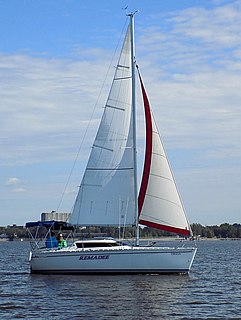Related Research Articles
The Newport 16 is an American trailerable sailboat that was designed by Bill Lapworth as a daysailer and a pocket cruiser and first built in 1965.

The Tonic 23 is a French trailerable sailboat, that was designed by Philippe Harlé as a coastal cruiser and first built in 1985.
The Balboa 24 is an American trailerable sailboat that was designed by W. Shad Turner and William Downing as a racer-cruiser and first built in 1981.
The Aquarius 23 is an American trailerable sailboat that was designed by Peter Barrett and Stan Miller as a cruiser and first built in 1969.
The Balboa 20 is an American trailerable sailboat that was designed by Lyle C. Hess as a cruiser, at the request of Richard Arthur and first built in 1967.
The Buccaneer 240 and Buccaneer 245 are a family of American trailerable sailboats that were both designed as cruisers and first built in 1975.
The Coronado 25 is an American trailerable sailboat that was designed by Ed Edgar and Frank W. Butler as a cruiser and first built in 1966.
The Dehler 22 is a West German trailerable sailboat that was designed by E. G. van de Stadt and first built in 1983. It is van de Stadt's design number 374.
The Elite 25, also called the Feeling 720 NV, is a French trailerable sailboat that was designed by Michel Joubert of Joubert-Nivelt as a cruiser and first built in 1982.
The Golif 21, or just Golif, is a French trailerable sailboat that was designed by P. Jouët & Cie as a pocket cruiser. It was named for the fictional pirate, Louis Le Golif and first built in 1961.
The Hermann 22, also called the Hermann 20 for its waterline length, is an American trailerable sailboat that was designed by Richard P. Ketcham Jr. as a cruiser and first built in 1961.
The Bahia 22, also called the Bahia 23, is a French trailerable sailboat that was designed by Philippe Harlé as a pocket cruiser and first built in 1983.
The Morgan 22 is an American trailerable sailboat that was designed by Charley Morgan as a racer-cruiser and first built in 1968.
The Neptune 24 is an American trailerable sailboat that was designed as a cruiser and first built in 1978.
The O'Day 20 is an American trailerable sailboat that was designed by John Deknatel of C.R. Hunt & Associates as a pocket cruiser and first built in 1973.
The O'Day 222 is an American trailerable sailboat that was designed by C. Raymond Hunt Associates as a cruiser and first built in 1984.
The Santana 2023 is a family of American trailerable sailboats that was designed by Steve Schock, with models for racing and cruising, first built in 1993.
The Seafarer 24 is an American trailerable sailboat that was designed by McCurdy & Rhodes as a cruiser and first built in 1974.
The Starwind 19, Starwind 190 and Spindrift 19 are a family of American trailerable sailboats that were designed by Jim Taylor Yacht Designs as cruiser-racers and first built in 1982.
The Windrose 22 and Laguna 22 are a series of American trailerable sailboats that were designed by W. Shad Turner as cruisers and first built in 1977.
References
- 1 2 3 4 5 6 McArthur, Bruce (2020). "Aquarius 21 sailboat". sailboatdata.com. Archived from the original on 6 January 2021. Retrieved 6 January 2021.
- ↑ McArthur, Bruce (2020). "Peter Barrett 1935 - 2000". sailboatdata.com. Archived from the original on 5 January 2021. Retrieved 6 January 2021.
- 1 2 3 McArthur, Bruce (2020). "Balboa 21 sailboat". sailboatdata.com. Archived from the original on 6 January 2021. Retrieved 6 January 2021.
- 1 2 3 4 5 6 7 8 9 10 11 Henkel, Steve: The Sailor's Book of Small Cruising Sailboats, page 81. International Marine/McGraw-Hill, 2010. ISBN 978-0-07-163652-0
- ↑ McArthur, Bruce (2020). "Coastal Recreation Inc. 1968 - 1981". sailboatdata.com. Archived from the original on 29 August 2020. Retrieved 6 January 2021.